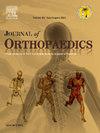单室膝关节置换术后前膝关节疼痛的危险因素调查:一项病例对照研究
IF 1.5
Q3 ORTHOPEDICS
引用次数: 0
摘要
目的本研究的目的是识别和分析单室膝关节置换术(UKA)后与前膝关节疼痛(AKP)相关的危险因素,并探讨导致这种术后并发症的潜在机制。方法本病例对照研究纳入了2018年至2022年间24例膝关节骨性关节炎患者的30个膝关节。根据术后AKP的存在与否将参与者分为两组。收集临床及影像学资料。采用Logistic回归分析确定AKP的独立危险因素。结果30例患者中,7例(23.3%)出现AKP, 23例(76.7%)未出现AKP。影像学参数分析显示两组在术后髌骨倾斜角度、滑车沟角度、髌股内侧关节炎进展和术后髌骨内侧倾斜方面存在显著差异。Logistic回归分析发现内侧髌骨关节炎的进展是发生AKP的独立危险因素。此外,髌骨倾斜角度增加被认为是一个保护因素,而术后髌骨内侧倾斜被认为是一个危险因素。结论髌股内侧关节炎的进展是固定平台UKA后发生AKP的独立危险因素。术后髌骨倾斜和滑车沟角度可能影响病情的发展。这些发现强调了在UKA期间进行最佳种植体定位和有效的软组织管理以减轻术后并发症的必要性。本文章由计算机程序翻译,如有差异,请以英文原文为准。
Investigation of risk factors for anterior knee pain following unicompartmental knee arthroplasty: A case-control study
Objective
The objective of this study is to identify and analyze the risk factors associated with anterior knee pain (AKP) following unicompartmental knee arthroplasty (UKA) and to investigate the underlying mechanisms that contribute to this postoperative complication.
Methods
This case-control study encompassed 30 knees from 24 patients who underwent medial fixed-platform UKA for knee osteoarthritis between 2018 and 2022. Participants were categorized into two groups based on the presence or absence of postoperative AKP. Clinical and imaging data were collected. Logistic regression analysis was utilized to determine independent risk factors for AKP.
Results
Among the 30 knees assessed, 7 (23.3 %) exhibited AKP postoperatively, while 23 (76.7 %) did not report such pain. An analysis of imaging parameters revealed significant differences between the two groups regarding postoperative patellar tilt angle, trochlear groove angle, progression of medial patellofemoral arthritis, and postoperative medial tilt of the patella. Logistic regression analysis identified the progression of medial patellofemoral arthritis as an independent risk factor for the occurrence of AKP. Additionally, an increased patellar tilt angle was identified as a protective factor, whereas postoperative medial tilt of the patella was recognized as a risk factor.
Conclusion
The progression of medial patellofemoral arthritis is identified as an independent risk factor for AKP following fixed-platform UKA. The development of this condition may be influenced by postoperative patellar tilt and trochlear groove angle. These findings underscore the necessity for optimal implant positioning and effective soft tissue management during UKA to mitigate postoperative complications.
求助全文
通过发布文献求助,成功后即可免费获取论文全文。
去求助
来源期刊

Journal of orthopaedics
ORTHOPEDICS-
CiteScore
3.50
自引率
6.70%
发文量
202
审稿时长
56 days
期刊介绍:
Journal of Orthopaedics aims to be a leading journal in orthopaedics and contribute towards the improvement of quality of orthopedic health care. The journal publishes original research work and review articles related to different aspects of orthopaedics including Arthroplasty, Arthroscopy, Sports Medicine, Trauma, Spine and Spinal deformities, Pediatric orthopaedics, limb reconstruction procedures, hand surgery, and orthopaedic oncology. It also publishes articles on continuing education, health-related information, case reports and letters to the editor. It is requested to note that the journal has an international readership and all submissions should be aimed at specifying something about the setting in which the work was conducted. Authors must also provide any specific reasons for the research and also provide an elaborate description of the results.
 求助内容:
求助内容: 应助结果提醒方式:
应助结果提醒方式:


